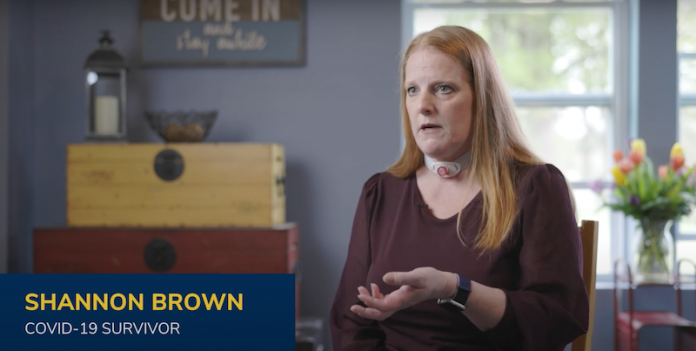
Three months ago, doctors told her she would die from rapidly progressing COVID-19. Now recovering, a 50-year-old Michigan woman is cautioning others and urging them to get vaccinated.
“I thought I would be fine – I hadn’t even had a cold in a couple of years – but I was not,” said Shannon Brown, a resident of Mattawan, a village near Kalamazoo.
“My children almost had to say goodbye to me. They had a prayer vigil for me. This isn’t just the frail and elderly that get critically ill.”
When COVID first came to Michigan, Brown, a former nurse of 23 years, took precautions. She “wore the mask and went about [her] life.”
During the pandemic’s second wave in late 2020, her family got infected. First, Geoff, her ex-husband. Then, her 14-year-old son, Karsten.
Brown wasn’t infected until March 2021 when her boyfriend, Jeff Stevens, showed symptoms.
“I remember thinking, ‘Jeff had it and got better, so I only have a few more days of this,’” Brown said. “It was just incredible pain. When I started getting shortness of breath later that week, I knew I was getting worse. It wasn’t going away.”
Struggling for air and unable to get out of bed, Brown told friends she feared her children would find her dead at home.
She had previously been sent home from an emergency room in her area, but her blood oxygen levels continued to dip below 85%. Brown’s friend drove her to another hospital where she was later admitted to the intensive care unit.
SEE ALSO: Nearly Half of COVID-19 Patients Left Hospital in Worse Physical Condition
“Within a couple days, I was coughing up blood,” Brown said. “I was breathing so rapidly, my doctor wondered how long I could keep it up.
My friends in medicine were telling me not to go on the ventilator, that COVID patients don’t do well on it. Eventually, I just couldn’t keep up the pace.”
Brown developed acute respiratory distress syndrome, or ARDS, a form of lung failure. She was intubated March 17, requiring 100% oxygen.
Around 6 p.m. a week later, flight nurses from Michigan Medicine’s Survival Flight team arrived at the Kalamazoo hospital where Brown was admitted.
They prepared her for transport to Michigan Medicine and evaluated her for ECMO, a critical care machine that bypasses the heart and lungs to pump oxygenated blood to the rest of the body.
The advanced therapy is complicated and often used when all other therapies fail to improve oxygenation.
“Our whole goal was to get her to [to Ann Arbor] before she needed ECMO,” said Ted Adelmann, R.N., a 15-year veteran flight nurse with Survival Flight.
“We started her on inhaled nitric oxide therapy. We were able to oxygenate and ventilate her much better once we arrived, which made a huge difference by the time we dropped her off at the surgical ICU at Michigan Medicine.”
An hour later, Brown’s family held collective breath as the helicopter took off. Jonah captured it all on camera.
“I was probably hiding behind it by taking pictures and video,” Jonah Brown said. “It was hard for me to process how insane of a situation it was.
I was trying to stay positive, but I actually thought she was not going to make it. My dad and cousin told me it was her last remaining hope.”
Brown was admitted to the surgical ICU with severe hypoxemia, acute kidney injury and septic shock.
The surgical critical care team used every therapy available to improve her oxygenation, said Lena M. Napolitano, M.D., director of Surgical Critical Care at Michigan Medicine.
“She was on inhaled nitric oxide for weeks, and she required continuous dialysis to get the fluid out of her lungs,” Napolitano said.
“She began to get a little better with all of our other therapies, which included antibiotics because she had a bacterial superinfection.”
Following a successful tracheostomy, Brown woke up on April 5, nearly two weeks after her family was told there was nothing more to do for her.
The former nurse was able to leave the hospital with her niece and daughter, welcomed back to west Michigan with a neighborhood parade.
“They all pulled onto the street with sirens [going], neighbors with gators, golf carts, friends lining the road with balloons,” Brown said.
“It felt so good to have survived that. Everybody thinks I’m a miracle because I was at death’s door when I went to [U-M].”
Brown’s story is a resounding success: A woman with severe COVID-19 ARDS surviving despite its 50% predicted mortality rate.
But Napolitano and her staff say for every Shannon Brown, there are other patients in their unit who die from the virus – and those people are increasingly young.
“We have patients in our surgical ICU with ages ranging anywhere from 20s to 40s and 50s,” she said. “In the first wave, it was an older population that was being targeted by the virus.
But in the second and third waves, we started seeing a large number of very young and healthy individuals. We know, in part, it’s related to the variants of the virus and to lack of vaccination.”
Over the course of the pandemic, Survival Flight has transported around 200 patients with severe COVID-19 from hospitals all over Michigan. They have received anywhere from one to four calls a day.
Even at Michigan Medicine, an acute respiratory distress syndrome referral center with access to therapies unavailable at many hospitals, there is no magic bullet to eliminate severe COVID-19.
This leads to longer stays and more trauma for younger patients, Napolitano said.
“We would love to walk every person in the country through our surgical ICU to see a unit full of young, healthy, critically ill patients with COVID-19 ARDS, so that it could convince them to get vaccinated,” she said.
Brown actively posts updates about her recovery on social media as a tale of celebration and caution. Several of her friends reported getting the vaccine after reading her messages – which is why she plans to keep posting.
“When it happens to someone close to you, and you see it, that makes things pretty darn real,” Brown said. “I don’t have a hole in my neck now because of a hoax virus. I know some people are not medically able to receive the vaccine.
For those who can, my story shows the importance of getting the shot. You can die from this, and you’re not bulletproof.”
Written by Noah Fromson.
If you care about COVID, please read studies about a strong link between COVID and this brain disease and findings of this new vaccine can block COVID-19 and variants, plus other coronaviruses.
For more information about COVID and your health, please see recent studies about people with this heart problem 5 times more likely to die in COVID-19 and results showing that a common drug for heart disease may reduce COVID-19 risk.



